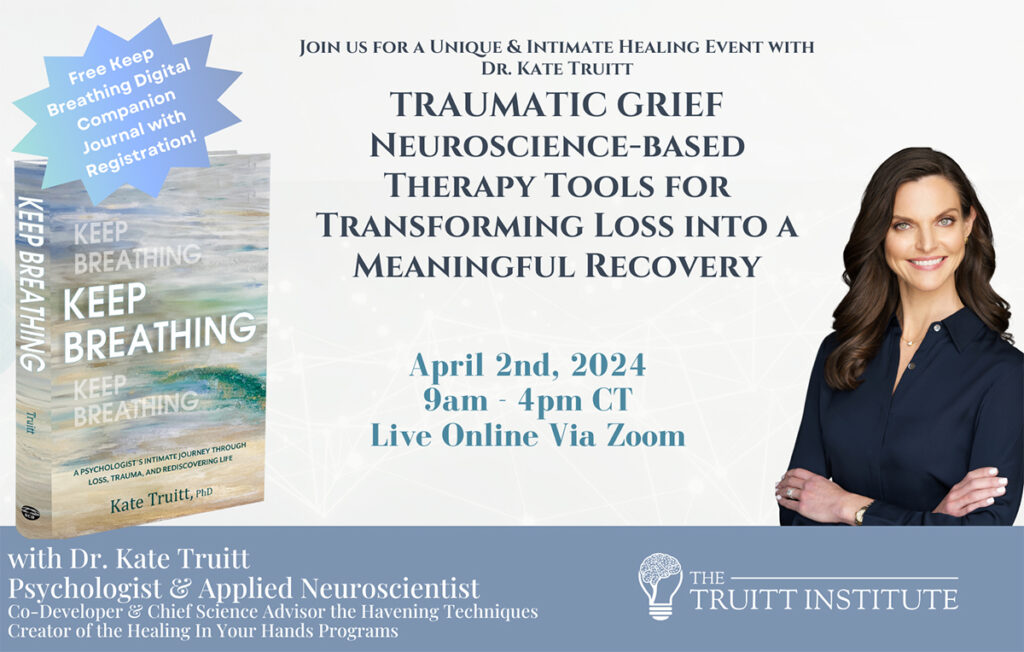Related Resources
For Havening Techniques®
Posttraumatic Growth & Grief: New Opportunities for Building the Future
Dr. Kate Truitt delves into the profound journey of healing from traumatic grief, guiding us towards the transformative experience of posttraumatic growth. This process, which she resonates with the regenerative rise of a Phoenix, is deeply rooted in our neurobiological makeup, empowered by the brain’s capacity for change known as neuroplasticity.
A Self-Havening Guided Meditation for Grief and Loss
Dr. Kate Truitt is no stranger to the nature of grief and loss. After being widowed a week before her wedding in 2009 she embarked on a five year journey back to finding herself. What was once a unique story of devastating traumatic loss is now the story of so many in the wake of the pandemic. Unexpected and agonizing loss is tearing lives asunder. In this guided meditation she shares opportunities for self-connection, healing, and resiliency that only come through being in deep relationship with the painful wisdom gifted to us with loss.
The Rainbow of Grief and Healing: Leveraging the Brain's Power for Post-Loss Growth
By Dr. Kate Truitt
One of the most profound and inescapable human experiences is grief. For many, the mere mention of grief summons images of darkness and pain. We mourn those we’ve lost, and we yearn for the moments that have slipped through our fingers—moments that were never meant to end.
But what if our response to grief could be reframed? What if this emotion, with its stifling weight, could be transformed into a vehicle for growth?
The brain plays a key role in grief, with different areas working to process emotions and memories. Interestingly, remembering happy times activates similar brain regions as physical pain, suggesting the brain tries to balance sorrow with joy. And as mental health practitioners, we can help our clients welcome opportunities for posttraumatic growth.
Guiding Clients Toward Post-Traumatic Growth After Loss

As clinicians, we play a crucial role in helping clients who are navigating the complex emotions and challenges of post-traumatic grief and loss.
Here are some ways we can guide them toward welcoming opportunities for healing and growth:
- Validate and normalize their experience by emphasizing that post-traumatic growth is possible.
Pay close attention to your client’s narrative, including the verbal and nonverbal cues. Use reflective responses that show you understand their experience, such as “It sounds like you’re feeling overwhelmed with grief” or “I understand why you feel angry and confused.”
- Encourage clients to explore their emotions through journaling, art therapy, or mindfulness exercises.
You can do this by providing safe spaces for clients to express their feelings openly and non-judgmentally. Another way is by teaching them healthy coping mechanisms such as the self-havening techniques.
I’ve created a Keep Breathing Companion Healing Toolkit where you’ll find journaling prompts to help clients express their emotions and gain self-awareness. You can use this for yourself and even share it with your clients. Get your free copy by signing up for our newsletter.

- Reframe the narrative of loss.
Help clients create a narrative of their loved one that includes not just the loss, but also the positive memories and lessons learned. Encourage reframing the experience of loss from being solely defined by the trauma to acknowledging the ongoing positive impact of the relationship.
In my upcoming book, Keep Breathing: A Psychologist’s Intimate Journey Through Loss, Trauma, and Rediscovering Life, I used storytelling to share my experience of unimaginable loss, trauma, and, ultimately, healing. And yes, healing is possible.
- Encourage clients to connect with others and have a support system.
Help them build a sense of community and belonging, fostering social connections that can buffer the impact of grief. Encourage clients to connect with supportive friends, family members, or grief support groups. Let them know they can still engage in activities that bring them joy and connect them to their values to help them find a sense of purpose and meaning.
- Use neuroscience-based tools
Introduce the concept of neuroplasticity and how the brain can change and heal even after traumatic experiences such as grief and sorrow. An example of this is the “Rainbow of Grief and Healing” we’ll be delving into. And if you’re looking to explore neuroscience-based tools, I encourage you to grab a copy of my book, Healing in Your Hands: Self-Havening Practices to Harness Neuroplasticity, Heal Traumatic Stress, and Build Resilience.
By using these strategies, we can guide our clients toward embracing the opportunities for healing and growth so they can move beyond the pain of loss and build a future filled with resilience and hope.
This April, I’ll be leading a free 6-hour live online training on Traumatic Grief: Neuroscience-based Therapy Tools for Transforming Loss into Meaningful Recovery. Register for free today for 14-day access to the training.

Tool for Therapists: The Rainbow of Grief and Healing

Guiding clients through grief, where the music of the mind plays a tune of both loss and love, is a delicate endeavor. The journey is not about the harsh finality of “letting go” or forcing one’s self to start “moving on”. It’s about honoring an enduring, loving connection with the departed, harmonizing the bitter with the sweet for long-term healing.
The “Rainbow of Grief and Healing” therapeutic tool is a beautiful exercise that allows clients to partner with their brain during this tender journey, transforming their grief into a spectrum of healing colors and meaningful stories. This is one of the neuroscience-based tools in my book, Healing in Your Hands: Self-Havening Practices to Harness Neuroplasticity, Heal Traumatic Stress, and Build Resilience.
The essence of this tool lies in its capacity to unite the multitude of memories, despite the pain that may cloud the present moment. It acknowledges the duality of grief—the sorrowful alongside the joyful—and seeks to reconcile these by empowering the positive. It invites clients to delve into the colors of their experiences, each hue representing a cherished memory or an emotional echo of their loved one.
Here’s how it works:
As clients process their grief, they are encouraged to identify five different colors that are present in their current experience of grief. Each color represents a memory or an aspect of their relationship with the deceased. This method of associating memories with colors allows clients to organize their emotions, providing a sense of grounding when feelings become overwhelming.
Clients then create a narrative for each color—a memory that includes their departed loved one. They write about these narratives in a journal, crafting stories about their loved one’s impact on their lives. This exercise offers a chance for clients to carry the memories of their loved ones in a healthy way. This process is not only cathartic but also affirms the enduring connection that surpasses physical separation.
If the emotional intensity—measured by the Subjective Units of Distress Scale (SUDs) – a scale that gauges the intensity of personal emotions and inner experiences range from 0 to 10, where 0 represents a state of neutrality or calmness, and 10 signifies the highest degree of intensity—rise above a threshold, clients are guided to transition to CPR for the Amygdala, a technique that offers emotional respite and grounding. Once steadied, they return to their colorful journey of memories.
At the end of the exercise, clients can review their stories and contemplate a desired emotional state they would like to have more of when their brain inevitably remembers their loss. During these moments, we can encourage our clients to use the Creating Possibilities Protocol to help them create a resilience anchor for their grief. This part of the exercise is a powerful affirmation that processing grief does not cut the connection with our loved ones and only transforms it.
Clients are then empowered to carry the positive forward into their lives, connecting to new energy for future experiences. This could be through actions that honor their loved one, choices that reflect learned wisdom, or simply holding onto the warmth of memories that continue to shape their lives.
The “Rainbow of Grief and Healing” is a therapeutic tool that complements the brain’s natural healing processes. It respects the neuroscience of grief—the way our minds grasp at threads of the past to weave a tapestry of comfort. It’s a tool that aligns with the mind’s desire to find equilibrium, to process pain with the same neural networks that once basked in the joy of togetherness.
Conclusion
In our roles, we have the privilege of introducing this exercise to those we serve, offering them a way to articulate their grief in hues that speak of love just as loudly as they do of loss. It’s a process that reassures clients that although the music may have changed, the dance of remembrance and connection continues, ever vibrant, ever meaningful.
The “Rainbow of Grief and Healing” encourages acknowledging both the pain and the positive aspects of memories. By understanding the brain’s role in grief and actively engaging in healing, individuals can move towards a future filled with both growth and cherished memories.
References
O’Connor, M.-F. (2021, December 20). Grief, loss, and the holiday brain: How healing happens. NPR. Retrieved from: https://www.npr.org/2023/12/18/1219956639/how-to-deal-with-grief-during-the-holidays
Shulman, L. M. (2021, September 29). Healing Your Brain After Loss: How Grief Rewires the Brain. American Brain Foundation. Retrieved from: https://www.americanbrainfoundation.org/how-tragedy-affects-the-brain/
Stroebe, M., Schut, H., & van den Bout, A. (2017). Grief: A brief history of research on how body, mind, and brain adapt. Omega , 74(4), 455-473. [PMC] [PubMed]
Shulman, L. M. (2021, August 10). How the brain responds to grief can change who we are. Aeon. Retrieved from: https://aeon.co/essays/how-the-brain-responds-to-grief-can-change-who-we-are










